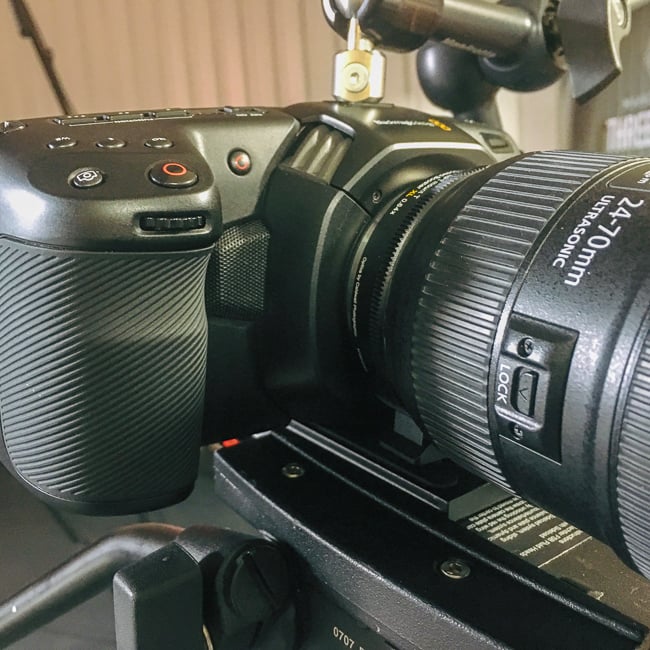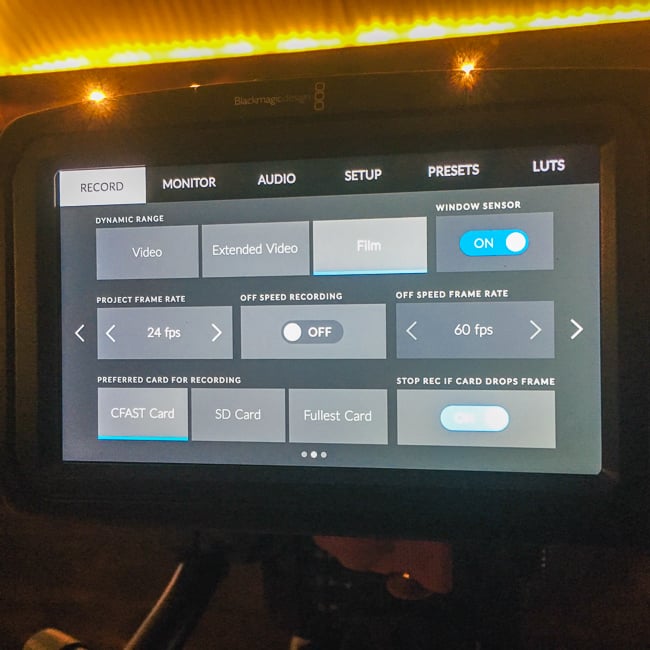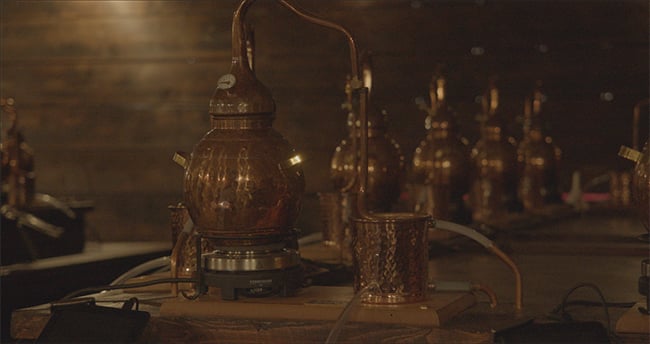
It is very hotly awaited, but we finally got to have a good play with a near final version of the BMPCC4K.
This week Blackmagic Design held a launch event for the new Pocket Cinema Camera 4K in the UK ahead of the forthcoming IBC show. It was a chance for the company to show off the highlights of the new camera to a select group of journalists, and to give us an opportunity to have a very solid amount of hands on time with the new device.
One thing that stood out at the event was how proud the company was of the new camera. A lot of work has been going into it to get it just right, with aspects such as the user interface and, importantly, the colour science being a big focus of that effort. In fact Blackmagic sees the product as another leap forward in its coming of age as a camera manufacturer.
We were taken through the thought processes that went on behind the design, as well as some of the more technical aspects of its dynamic range and the different gamma modes. There was a lot to take in, but there was one thing that stood out, and that’s the fact that while superficially it might look similar to some of the mirrorless cameras out there, the BMPCC4K is a completely different animal altogether.
We work hard as journalists you know, so we were taken on a trip to a gin distillery, a location that was selected due to its interesting design and lighting, which I’ll come to in a moment. We were split into groups and took it in turns to visit the different areas of the distillery, whereupon we were taken through the different aspects of the camera, from user interface and set-up, through to dynamic range and exposure.

Parts of the location were lit with a mixture of consumer tungsten and film LED lights. The camera coped nicely. Skin tones looked very good.
It’s light
Picking up the BMPCC4K for the first time, and the light weight of it becomes very apparent, thanks to the new polycarbonate body. Clearly the final carry weight will depend on the lens you use, but with lightweight and compact glass the BMPCC4K will be very light indeed, which will help to make fast handheld work much easier than heavier equivalents, as well as helping endurance when attached to a gimbal.
It’s a comfortable camera to hold, with rubberised hand grip areas and well placed controls, and the rear screen appears to be exceptionally good. It’s bright and I found that I could view it from very acute angles without any brightness changes or difficulty in framing. It allayed my initial concerns about not having a flip out screen, which would have added complexity and cost to the camera.

Clear and simple controls layout, and a nice rubberised hand grip
We have had questions on RedShark before asking about the advantages of the BMPCC4K over one of the other mirrorless cameras. After all, isn’t the BMPCC4K just a mirrorless camera without the stills capability? Umm, no. As it happens there are quite a few advantages to the BMPCC4K, made possible by the differences in approach between a company focussing on making a camera that produces great video vs a company that is making a camera to do both stills and video.
For a start the controls are greatly simplified. Everything is designed around video, so all the important controls can be accessed either by using the touch screen, or by the buttons on the camera body. But because this camera has been designed around one purpose there isn’t a jumble of buttons to remember. They are all nicely spaced out and readily accessed. On the top of the camera are some air intakes, and a quiet fan produces the cooling while ejecting the warm air through another vent on the bottom of the body. This might sound backward since often intakes are on the underneath of a camera. But it makes sense since you won’t block the cooling system as easily if you put the camera on the floor.

Either side of the lens are two mic housings which are home to four microphones, tuned for vocal pick-up
The picture
The previous BMPCC wasn’t known for its low noise. It produced a fantastic picture, but it wasn’t exactly a low light performer. Fast forward to the BMPCC4K and things have changed, a lot. The new camera has dual native ISOs of 400 and 3200. However the camera will switch automatically to the upper gain circuit at ISO1250. Using ISO settings above or below those two native settings will have an effect on dynamic range, but only minimal. And this is extremely important to consider. Blackmagic Design has made the ISO adjustable in quarter stop increments from ISO100 up to ISO25,600, so there is a hugely varied number of settings. This means that you have an incredible amount of control over the picture since you can set the f-stop you want, and effectively fine tune the exposure with the ISO without any fear of compromising the picture much. How? Because the BMPCC4K produces a picture with incredibly low noise.
Put simply, from what I saw and tried myself, the BMPCC4K would appear to be a low light beast. It was seeing into incredibly dark areas much better than my own eyes could. Even with the ISO setting maxed out at 25,600 the noise levels appeared perfectly acceptable, but even still it would be a simple matter to remove it within Resolve. It was demonstrated to us using the false colour exposure mode how the noise levels change when the gain circuit switches, such that in some cases it is better to switch to the upper gain mode and stop down. During the initial demonstration we were shown some quite impressive examples of both drastic under and over exposure post production recovery, demonstrating how well the camera captures detail in the shadows and highlights.
There's no OLPF in the camera, however from the footage I have seen this doesn't appear to be an issue. Unlike the much lower resolution of the original camera, at 4K resolutions any issues that might arise from this would appear to be imperceptible. Clearly this will need more testing in a final review camera, but I couldn't spot anything of concern in the footage I saw.

Very clear OSD with everything touch adjustable. Note the tiny Angelbird SSD plugged into the USB-C port
Another aspect that looked good was the extended video mode. The intention behind this is to give a ready to use picture that needs minimal to no grading, yet still captures an acceptable dynamic range. Think of it as halfway point between rec.709 and the BMD Film mode. From first appearances I can see this setting getting a lot of use. It does indeed produce a nice looking, natural picture. And while it doesn’t capture the same sort of dynamic range as Film mode, it still coped very well with both dark regions and highlights from what I could tell. Obviously the real proof in the pudding will come when we receive a review sample to look at more closely. But what I have seen so far is incredibly promising.
Rolling shutter appears to be very well controlled with a much faster readout than the previous camera. We were shown the debut of a new video showing off how the camera performs in high action shooting environments, and I think you’ll agree it appears to cope very well indeed.
Another little test I did was to see if there was any delay on the LCD screen between moving the camera. Again, the LCD response appeared instant with no delay that I could detect.
User interface
The user interface, as has been the case with Blackmagic’s other cameras so far, is very well laid out and extremely clear. The camera has the ability to load custom LUTs, and these can either be used as a monitoring reference or they can be baked in. When set to bake-in mode the LUT indicator on the screen appears red so you hopefully won’t bake in a look unintentionally. One of the things that Blackmagic emphasised to us was that it had made great efforts to avoid the cluttered, complex menus seen elsewhere. From what I could see it has succeeded. Everything was big and nothing was hidden away. In fact once it was initially set up, it is unlikely you’ll need to go into the main settings menu again since all other controls are accessible simply by touching the relevant setting in shooting mode.

Possibly the clearest and easiest to use set-up interface on any camera available
Recording can be done in three ways. On CFast 2 cards, SD cards, or by hooking up an SSD to the USB-C port. Some of the demo cameras had tiny Angelbird SSDs connected to them. It isn’t possible unfortunately to record to both the SSD via USB-C and to a CFast or SD card simultaneously. HDMI out is to the 1.4 standard. It’s a full sized socket, but limited therefore to 1080p, but with 10-bit colour and 422 colour sampling. Now, I know what you are thinking, and that’s that it won’t be possible to record 4K externally to a recorder. But if you stop and think, it makes no sense to record to an external device when the camera itself can record both 10-bit 4K ProRes and 12-bit raw to both card media or plugged in SSD. There is perhaps a case for outputting to larger 4K monitors on set, but it should still be considered that this is a camera designed for shooting on the move guerrilla style. It’s not a studio camera.
Battery life
The cameras we saw were getting between 50 mins and an hour depending on the shooting mode being used. Now this might not seem a lot, but remember what the camera is doing. You don’t put this sort of capability into a camera without some sort of compromise. Luckily the Canon E6 type batteries that it uses are very easily obtainable. I have around eight myself. As a result, swapping them out isn’t such a big deal. The battery cover has been designed to be detachable so that third parties could make a plug in battery grip/pack if they wanted to. Alternatively the camera can be powered off something like D-Tap into the DC in socket. Thankfully this iteration of the DC socket is bigger and more robust than the one on the original Pocket Cinema Camera. Lastly, you can also plug in a USB power pack into the USB-C socket to charge the battery that is inside the camera. You can’t actually run the camera off such a pack, but it does give you another option for charging.

A frame from a lowlight shot taken in the Distillery, taken at 4000 ISO in DNG Raw, ungraded

The same shot with the new BMPCC4K-Extended Video LUT within DaVinci Resolve 15.01 applied. This exposure is what the location looked like to the naked eye. The camera can cope with much, much darker conditions with ease. In other words what you are seeing here is a realistic exposure.

100% crop of an ungraded DNG Raw shot taken at 4000 ISO.

Another 100% crop with the new BMPCC4K-Extended Video LUT within DaVinci Resolve 15.01

An ungraded ProRes HQ shot taken from one of the BMD test shoots.

The same shot with the new BMPCC4K-Extended Video LUT within DaVinci Resolve 15.01 applied. This shows you how pleasing the Extended Video mode for the camera is. You can apply this as a LUT in Resolve, or select it in camera and bake it in during recording.
What are its advantages over other cameras?
Let’s return to that earlier question of what the BMPCC4K offers over and above simply getting an existing mirrorless camera. It has been designed primarily around producing video, and this has resulted in controls and an interface that allow you to shoot moving images fast. It is of course a lot less expensive than almost all alternative cameras. It can record 4K raw internally, as well as 10-bit ProRes, which no other camera this size or price point can do.
Your options for recording media are also wide and varied. Again something that no other direct alternative offers. Shooting directly to an SSD means you can take it straight to your editing room and get working on things without delay, and you won’t have the bulk of an external recorder to deal with. The BMPCC4K also has quiet audio circuits and a built in mini XLR, something that no alternative mirrorless camera has unless you purchase a costly add on device, which adds bulk and weight as well. Being able to record reliable audio straight into the camera with no need for additional equipment is a very big factor when it comes to convenience. All of this means that the BMPCC4K will be a much more efficient camera to work with in a video environment than a device that has been designed to please both stills and video people.
What I have seen so far is impressive. All that remains now is for us to test a final device. There’s no word yet on a firm release date, but you can be sure that it is very close indeed.
Want to play with some original files from the camera? Blackmagic Design has you covered!
Tags: Production


Comments